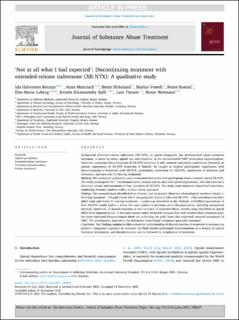| dc.contributor.author | Brenna, Ida Halvorsen | |
| dc.contributor.author | Marciuch, Anne | |
| dc.contributor.author | Birkeland, Bente | |
| dc.contributor.author | Veseth, Marius | |
| dc.contributor.author | Røstad, Bente | |
| dc.contributor.author | Løberg, Else-Marie | |
| dc.contributor.author | Solli, Kristin Klemmetsby | |
| dc.contributor.author | Tanum, Lars Håkon Reiestad | |
| dc.contributor.author | Weimand, Bente | |
| dc.date.accessioned | 2022-03-01T10:25:27Z | |
| dc.date.available | 2022-03-01T10:25:27Z | |
| dc.date.created | 2021-12-14T12:04:39Z | |
| dc.date.issued | 2021 | |
| dc.identifier.citation | Journal of Substance Abuse Treatment. 2021, 1-11. | en_US |
| dc.identifier.issn | 0740-5472 | |
| dc.identifier.uri | https://hdl.handle.net/11250/2982022 | |
| dc.description.abstract | Background: Extended-release naltrexone (XR-NTX), an opioid antagonist, has demonstrated equal treatment outcomes, in terms of safety, opioid use, and retention, to the recommended OMT medication buprenorphine. However, premature discontinuation of XR-NTX treatment is still common and poorly understood. Research on patient experiences of XR-NTX treatment is limited. We sought to explore participants' experiences with discontinuation of treatment with XR-NTX, particularly motivation for XR-NTX, experiences of initiation and treatment, and rationale for leaving treatment. Methods: We conducted qualitative, semi-structured interviews with participants from a clinical trial of XR-NTX. The study participants (N = 13) included seven women and six men with opioid dependence, who had received a minimum of one and maximum of four injections of XR-NTX. The study team analyzed transcribed interviews, employing thematic analysis with a critical realist approach. Findings: The research team identified three themes, and we present them as a chronological narrative: theme 1: Entering treatment – I thought I knew what I was going into; theme 2: Life with XR-NTX – I had something in me that I didn't want; and theme 3: Leaving treatment – I want to go somewhere in life. Patients' unfulfilled expectations of how XR-NTX would lead to a better life were central to decisions about discontinuation, including unexpected physical, emotional, or mental reactions as well as a lack of expected effects, notably some described an opioid effect from buprenorphine. A few participants ended treatment because they had reached their treatment goal, but most expressed disappointment about not achieving this goal. Some also expressed renewed acceptance of OMT. The participants' motivation for abstinence from illegal substances generally remained. Conclusion: Our findings emphasize that a dynamic understanding of discontinuation of treatment is necessary to achieve a long-term approach to recovery: the field should understand discontinuation as a feature of typical treatment trajectories, and discontinuation can be followed by re-initiation of treatment. | en_US |
| dc.language.iso | eng | en_US |
| dc.rights | Navngivelse 4.0 Internasjonal | * |
| dc.rights.uri | http://creativecommons.org/licenses/by/4.0/deed.no | * |
| dc.title | Not at all what I had expected: Discontinuing treatment with extended-release naltrexone (XR-NTX): A qualitative study | en_US |
| dc.type | Peer reviewed | en_US |
| dc.type | Journal article | en_US |
| dc.description.version | publishedVersion | en_US |
| dc.source.articlenumber | 108667 | en_US |
| cristin.ispublished | true | |
| cristin.fulltext | original | |
| cristin.qualitycode | 1 | |
| dc.identifier.doi | 10.1016/j.jsat.2021.108667 | |
| dc.identifier.cristin | 1968316 | |
| dc.source.journal | Journal of Substance Abuse Treatment | en_US |
| dc.source.pagenumber | 1-11 | en_US |
| dc.relation.project | Norges forskningsråd: 269864 | en_US |
| dc.relation.project | Helse Sør-Øst HF: 2019105 | en_US |

